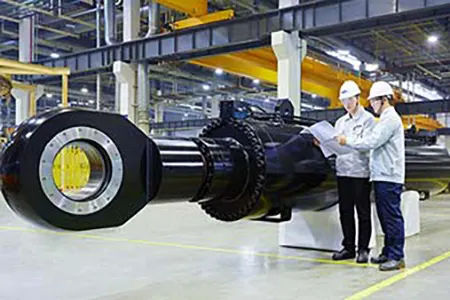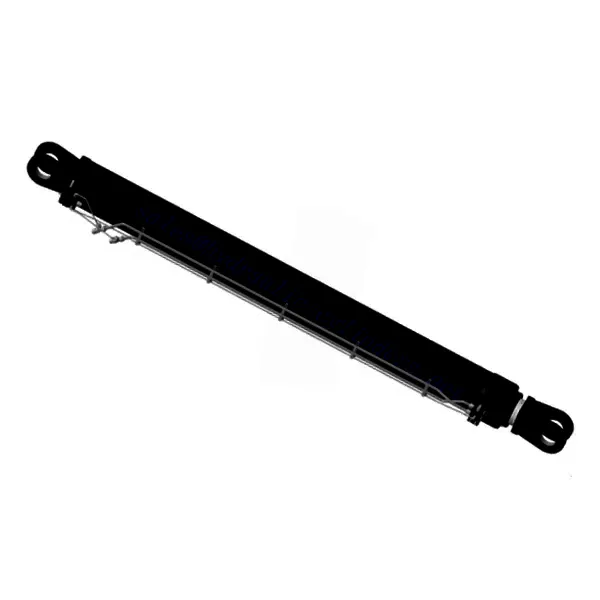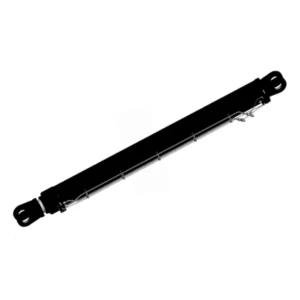Offshore Crane Folding Arm Tilt Cylinder
Como um dos fabricantes, fornecedores e exportadores de produtos mecânicos de cilindros hidráulicos, oferecemos cilindros hidráulicos e muitos outros produtos.
Entre em contato conosco para obter detalhes.
Correio eletrônico:sales@hydraulic-cylinders.net
Fabricante, fornecedor e exportador de cilindros hidráulicos.
Offshore Crane Folding Arm Tilt Cylinder
The offshore crane folding arm tilt cylinder is a cutting-edge hydraulic component designed to optimize the performance and versatility of offshore crane systems. This specialized cylinder is specifically engineered to control the folding and tilting movements of the crane’s arms, allowing for precise load positioning and improved operational efficiency in offshore lifting operations. With its robust construction, advanced features, and ease of integration, the offshore crane folding arm tilt cylinder is an essential tool for companies seeking to enhance their offshore lifting capabilities.
Folding and tilting movements of the crane’s arms. With enhanced versatility, robust construction, and easy integration, this cylinder optimizes offshore lifting operations, enabling operators to position loads accurately and efficiently. By following the recommended usage methods and implementing regular maintenance practices, companies can maximize the performance, longevity, and safety of their offshore lifting operations. With the offshore crane folding arm tilt cylinder, businesses can enhance productivity, versatility, and safety in their offshore lifting applications, ensuring efficient and successful operations in challenging offshore environments.
Offshore Crane Latch Cylinders (mechanical self-locking) Key Characteristics:
- Precise Arm Control: The folding arm tilt cylinder enables precise control over the folding and tilting movements of the crane’s arms. This allows operators to position the load with accuracy, improving overall productivity and reducing the risk of accidents during lifting operations.
- Enhanced Versatility: The cylinder’s design enables the folding arm system to rotate horizontally and tilt vertically, providing increased flexibility in load handling. This versatility allows operators to adapt to various offshore lifting scenarios, accommodating different load sizes, shapes, and positioning requirements.
- Robust Construction: Constructed from high-quality materials, such as corrosion-resistant alloys, the Offshore Crane Folding Arm Tilt Cylinder is built to withstand the harsh offshore environment. Its durable construction ensures reliable performance and longevity, reducing maintenance needs and operational downtime.
- Easy Integration: The cylinder is designed for seamless integration into existing offshore crane systems. It can be easily installed and connected to the hydraulic circuit, utilizing the crane’s existing hydraulic power source and control system. This simplifies the installation process and minimizes downtime during the integration.
Offshore Crane Latch Cylinders (mechanical self-locking) Parameter:
| Product Name | Offshore Crane Folding Arm Tilt Cylinder |
| Features: | Provide thrust force and pulling force used to adjust the horizontal angle of the crane’s forearm |
| Bore diameter: | Up to 580mm |
| Rod diameter: | Up to 400mm Stroke up to 5170mm |
| Thrust force /Pulling force: | Maximum 8454KN/3589KN (Cylinders diameter 580mm/pressure 32MPa) |
| Applications: | Offshore Crane |
Offshore Crane Cylinder Factory:

Usage Method Of Offshore Crane Main Boom Luffing Cylinder:
- Installation: Install the offshore crane folding arm tilt cylinder in the appropriate location on the crane’s folding arm system, ensuring proper alignment and secure mounting. Follow the manufacturer’s guidelines and specifications for installation procedures, torque values, and any specific considerations for your crane system.
- Hydraulic Connections: Connect the cylinder to the hydraulic system of the offshore crane, ensuring proper routing of hydraulic lines and secure connections. Follow the manufacturer’s recommendations for hose sizes, fittings, and pressure ratings to ensure safe and efficient operation.
- Control and Operation: The folding arm tilt cylinder is typically controlled through the crane’s existing hydraulic control system. Use the control console or control panel to activate the hydraulic circuit and adjust the folding and tilting movements of the crane’s arms as required during load-handling operations.
How Do You Size A Hydraulic Cylinder?
Sizing a hydraulic cylinder involves determining the appropriate dimensions and specifications of the cylinder based on the specific application requirements. Here are the general steps to size a hydraulic cylinder:
- Determine the Load Requirements: Calculate the force or load the hydraulic cylinder must exert. This can be done by considering factors such as the object’s weight, the desired speed of movement, and any additional forces or resistance that need to be overcome.
- Calculate the Required Cylinder Area: Divide the load by the hydraulic pressure to calculate the required cylinder area. The formula is:Cylinder Area = Load / Hydraulic Pressure
Ensure the load and pressure units are consistent (e.g., pounds-force and psi).
- Select the Cylinder Bore Diameter: Using the calculated cylinder area, determine the appropriate bore diameter of the cylinder. The bore diameter is the internal diameter of the cylinder barrel and directly affects the cylinder’s force output. Refer to manufacturer catalogs or consult hydraulic engineering resources to find cylinders with suitable bore diameters.
- Consider Safety Factors: It’s essential to apply safety factors to account for any variations or uncertainties in the application. System efficiency, dynamic loads, and safety margins should be considered to ensure reliable and safe operation. Consult industry standards, guidelines, or experienced hydraulic engineers for appropriate safety factors.
- Check Cylinder Stroke Length: Determine the required stroke length of the cylinder. The stroke length is the maximum distance the cylinder’s piston can travel. Consider the range of motion needed for the application and ensure the selected cylinder stroke length can accommodate it.
- Consider Cylinder Mounting: Evaluate the hydraulic cylinder’s available space and mounting options. Consider factors such as cylinder length, rod end style (e.g., clevis, trunnion, or spherical bearing), and the required mounting configuration (e.g., flange, foot, or pivot mount). Ensure that the selected cylinder can be properly mounted in the desired location.
- Review Cylinder Specifications: Consider other specifications and features of the hydraulic cylinder, such as maximum operating pressure, operating temperature range, material compatibility, and seal options. These factors can influence the cylinder’s performance and suitability for the specific application.
- Consult Manufacturer and Application Experts: If you have complex or specialized requirements, it’s advisable to consult with hydraulic cylinder manufacturers or experienced application engineers. They can provide valuable guidance, recommend specific cylinder models, and assist in selecting the most appropriate cylinder for your application.
Aptidão e capacidade da fábrica:
(1) Montagem
Temos uma plataforma de montagem de pesquisa e desenvolvimento independente de primeira classe. A oficina de produção de cilindros hidráulicos tem quatro linhas de montagem semiautomáticas de cilindros de elevação e uma linha de montagem automática de cilindros de inclinação, com uma capacidade de produção anual projetada de 1 milhão de peças. A oficina de cilindros especiais é equipada com várias especificações de um sistema de montagem de limpeza semiautomática com uma capacidade de produção anual projetada de 200.000 peças e equipada com famosos equipamentos de usinagem CNC, um centro de usinagem, um equipamento especial de processamento de cilindros de alta precisão, uma máquina de solda robotizada, uma máquina de limpeza automática, uma máquina de montagem automática de cilindros e uma linha de produção de pintura automática. O equipamento crítico existente é de mais de 300 conjuntos (conjuntos). A alocação ideal e o uso eficiente dos recursos do equipamento garantem os requisitos de precisão dos produtos e atendem às necessidades de alta qualidade dos produtos.


(2) Usinagem
A oficina de usinagem é equipada com um centro de torneamento de trilho inclinado personalizado, um centro de usinagem, uma máquina de brunimento de alta velocidade, um robô de soldagem e outros equipamentos relacionados, que podem lidar com o processamento de tubos de cilindros com diâmetro interno máximo de 400 mm e comprimento máximo de 6 metros.

(3) Soldagem

(4) Pintura e revestimento
Com linhas de revestimento de tinta à base de água automáticas de cilindros de pequeno e médio porte, para obter carregamento e descarregamento automáticos de robôs e pulverização automática, a capacidade projetada é de 4.000 peças por turno;
Também temos uma linha de produção de tinta semiautomática para cilindros grandes, acionada por uma corrente elétrica, com capacidade de projeto de 60 caixas por turno.


(5) Testes
Temos instalações de inspeção e bancos de teste de primeira classe para garantir que o desempenho do cilindro atenda aos requisitos.

We are one of the best hydraulic cylinder manufacturers. We can offer comprehensive hydraulic cylinders. We also provide corresponding caixas de câmbio agrícolas. Exportamos nossos produtos para clientes em todo o mundo e conquistamos uma boa reputação devido à qualidade superior de nossos produtos e ao serviço pós-venda. Convidamos clientes nacionais e estrangeiros a entrar em contato conosco para negociar negócios, trocar informações e cooperar conosco!
Faça um tour pela nossa fábrica de RV:
Faça um tour pela nossa fábrica de RV com o seguinte
Como funciona o cilindro hidráulico da empilhadeira?
Cilindro hidráulico Aplicação:



